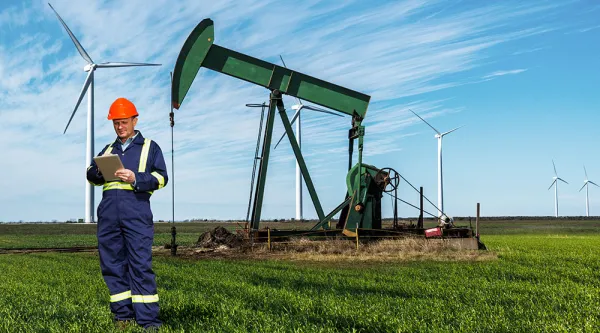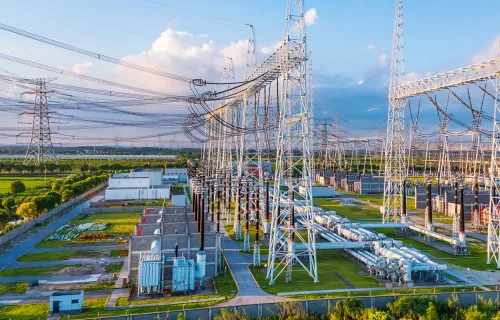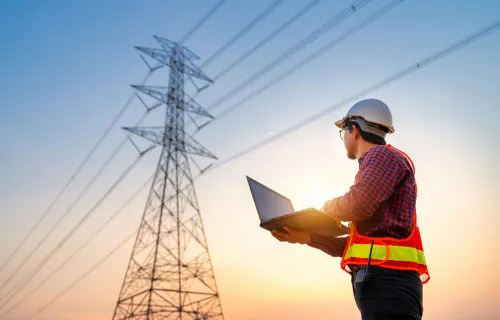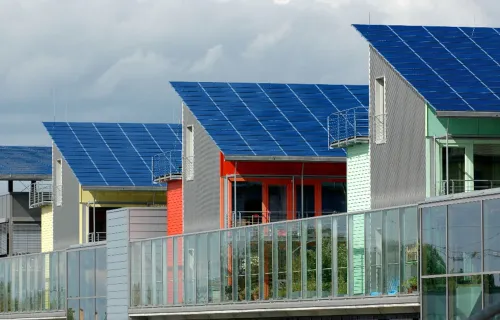In part two of CGI’s latest Energy Transition Talks episode, host Angelina Bakshi continues her conversation with Frank Schmidt, Vice-President for CGI’s Global Energy Sector. They explore how oil and gas companies are evolving legacy operations through hybrid portfolios, digital infrastructure and cross-sector partnerships—while building resilience amid volatility.
Catch up on the first instalment of the conversation: From AI to cloud - How oil and gas is digitally rewiring for profit and net-zero impact
Optimizing hybrid portfolios with digital intelligence
To avoid redundant spending while supporting energy transition goals, organizations are increasingly managing hybrid portfolios that combine traditional and renewable assets. Frank outlines three core enablers:
- Digital energy modeling to simulate and optimize full system portfolios
- Edge computing and AI to support real-time performance monitoring
- Hybrid asset configurations (e.g., solar-plus-storage or LNG-plus-hydrogen) to balance reliability with capital efficiency
This strategy also includes leveraging subsurface expertise to repurpose oil and gas infrastructure for carbon or hydrogen storage, creating long-term value from legacy investments.
“The same technology used to extract oil and gas is now being applied to store carbon or hydrogen.”
– Frank Schmidt
Balancing risk and reward in LNG and hydrogen
Hybrid portfolios bring both opportunity and complexity. LNG provides near-term reliability and market flexibility, while hydrogen holds long-term potential for decarbonization. Companies are exploring integration strategies—like blending hydrogen into LNG systems—to reduce transition costs and expand optionality.
However, challenges remain. Frank points to LNG price volatility, uncertain hydrogen economics and regulatory shifts as financial risks that can strain balance sheets and impact asset valuations. These factors demand robust scenario modeling and investment discipline.
Extending asset lifecycles through digital infrastructure
Modernizing terminals, pipelines and production assets is key to improving system resilience. Frank highlights how technologies like predictive analytics, digital twins and IoT sensors are now widely used to optimize operations across offshore and onshore assets.
By enabling remote monitoring, proactive maintenance and simulation-driven planning, these tools help reduce downtime, improve safety and extend the useful life of critical infrastructure.
One example: pipeline inspections that once required flying personnel to rigs can now be completed remotely or with on-site support—saving time and operational cost.
Measuring value: KPIs that matter
Executives are increasingly turning to data to justify and guide their investments. According to Frank, leading companies track:
- Energy production efficiency (output vs capacity)
- System availability (uptime across assets)
- Carbon intensity (emissions per unit of energy)
- Return on investment (from digital upgrades and hybrid systems)
These metrics quantify both financial and sustainability outcomes, making them essential tools for prioritizing digital transformation initiatives.
Accounting for hidden exposures
Volatility in energy markets isn’t just about prices. Frank highlights a range of hidden cost drivers, including:
- Geopolitical tensions affecting fuel routes and renewables supply chains
- Climate volatility increasing insurance costs and asset damage risk
- Cyber threats that can cause cascading failures across energy infrastructure
To mitigate these risks, companies are investing in diversified portfolios, strategic reserves and stronger digital resilience strategies, including cybersecurity and incident response planning.
“Digital resilience isn’t just a cybersecurity issue—it’s foundational to energy security.”
–Frank Schmidt
De-risking energy infrastructure through partnerships
Public-private partnerships are emerging as a powerful model for accelerating infrastructure development while sharing financial and operational risk. Governments bring policy support and permitting; private firms contribute capital and execution expertise.
This collaboration is especially critical in hard-to-abate sectors like chemicals and hydrogen, where capital intensity and risk are highest. By pooling resources, public and private actors can co-develop infrastructure that supports decarbonization, energy security and economic growth.
From subsurface to systems: Building future-ready infrastructure
As the industry adapts to new technologies and shifting regulatory landscapes, leaders are focusing on strategies that build resilience and flexibility into their operations. This includes:
- Digitally modeling before building to simulate system behavior
- Leveraging legacy expertise for new use cases (e.g., hydrogen storage)
- Balancing near-term LNG stability with long-term hydrogen opportunity
- Measuring performance through ROI, uptime and carbon intensity
Frank’s key message is clear: forward-thinking energy organizations are those that optimize for both today’s realities and tomorrow’s transitions, without duplicating investment or exposing themselves to unmanaged risk.
Listen to other podcasts in this series to learn more about the energy transition
Read the transcript
- Integrating legacy and low-carbon systems without duplication
-
Angelina Bakshi
Hello, good morning, good evening, good afternoon, wherever you're joining us from today. Welcome to Energy Transition Talks. My name is Angelina Bakshi and we're here to continue the conversation for part two of Transforming Energy Systems, Maximizing Return on Investment through Smarter and Secure Infrastructure. It's a pleasure for me to introduce my colleague Frank today for the conversation.
Frank Schmidt
Thanks for having me. My name is Frank Schmit. I'm vice president for the global energy sector within CGI and in that role supporting primarily one of our larger oil and gas clients we have already for over 30 years and also supporting other oil and gas clients that we have on the global scale.
Angelina Bakshi
Great. So, you know, we want to talk about integrating legacy and low carbon systems. And so how can companies optimize both traditional and renewable assets without creating cost duplications?
Frank Schmidt
That’s a good question because cost is of essence in nowadays energy world. So if you look at energy companies, they are increasingly adopting hybrid asset strategies that integrate traditional and renewable systems through digital platforms. First of all, I see the use of digital energy systems modeling, which enables better simulation and optimization of entire portfolios and that avoids duplication in infrastructure and operations.
A second one I see is edge computing and AI that allows for real-time performance monitoring across both the fossil site and the renewable asset side and that identifies synergies and reducing redundancy.
And a third one I see is the use of hybrid energy systems. And for example, think about combining solar and battery storage or LNG with hydrogen, which ensures reliability while minimizing overlapping capital expenditure. And one of the examples where I think CGI is very knowledgeable due to our long-term experience in the subservice and wealth domain is optimizing the workflows in that subsurface and wells domain, but also using that technology that we used to use to get oil or gas out of the ground, but use same technology to store carbon or store hydrogen in that same well. So those are all optimization efforts and potential drivers that we see in the market that are very relevant.
- Weighing the financial risks and opportunities of mixed portfolios
-
Angelina Bakshi
So what are the financial risks and opportunities of mixed fuel portfolios? You know, we're seeing a lot of LNG, we're seeing a lot of hydrogen.
Frank Schmidt
Yeah, if you look at the opportunity side, I think that LNG provides short term reliability and arbitrage potential. Why hydrogen offers long term decarbonization upside.
Another opportunity is the flexible contracting and portfolio optimization, which can improve margins and reduce exposure to spot market volatility.
And a third one I see is hydrogen integration into LNG infrastructures, blending, co-locate, which can reduce transition costs significantly. On the risk side, I see, for instance, high price volatility in LNG markets and uncertain hydrogen economic situation, and that on its own can strain balance sheets.
And another one is regulatory shifts and carbon pricing, which may impact asset valuations and asset valuation for oil and gas companies is of crucial importance.
- Modernizing infrastructure to reduce cost and downtime
-
Angelina Bakshi
I want to talk a little bit more about something you've touched upon, around digital infrastructure at scale. we've, you know, we've talked about, we've heard about digital twins. How are terminals, grids, pipelines being modernized to reduce downtime costs and improve their asset life cycle?
Frank Schmidt
Well, what you see in that modernization effort is that oil and gas companies and the energy sector is focusing on a few important drivers like predictive analytics, virtualization, the use of digital twin and IoT sensors, which improves asset life cycles and reliability. So that is what you see happening all over the sector. And it goes across all assets, offshore, onshore, also in the chemicals side of things. You see that these, let's say, drivers are used more and more. And let me give one example. Imagine you need to go with a Haley to a rig to do a pipeline inspection.
If that same pipeline has IoT equipment so you can do it remote or you can have someone from the rig do the inspection with remote support that is for instance not on the rig that saves a lot of money and it's faster and it's cheaper.
- Providing digital ROI with meaningful KPIs
-
Angelina Bakshi
So you really are getting a return on investment fairly quickly here.
Frank Schmidt
Absolutely. It's very visible.
Angelina Bakshi
That leads me to a question that I often hear from executives of, you know, what are the key performance indicators that prove the cost-efficient effectiveness of these digital investments? Because they can be quite significant.
Frank Schmidt
Absolutely. So currently, if you look in the oil and gas sector and you focus on that side, you could, for instance, mention energy production efficiency, which measures the actual output versus capacity. More into the utility side, you could look at cost per kilowatt hour or megawatt hour, which tracks operational cost per unit of energy.
A traditional one, but still really important is system availability. So the uptime percentage across an asset. More environmental is carbon intensity. So emissions per unit of energy produced, for instance, and also a traditional one is the return on investment. So the financial return from a digital upgrade, for instance. And these are a set of KPIs that you see used a lot and these KPIs help quantify both financial and sustainability impact within the oil and gas sector.
- Hidden exposures: Volatility, climate and cyber risk
-
Angelina Bakshi
I really appreciate your commentary and description about some of the key performance indicators that oil and gas executives can focus on.
When we talk about building resilient and adaptive networks, because the reality is that we live in a fairly volatile place and energy security is top of mind for a lot of companies and governments and individual citizens. So how do geopolitical risks and climate volatility create hidden cost exposures?
Frank Schmidt
That's a very good question. Let me start by saying that hidden exposures arise from supply chain fragility, regulatory shifts and infrastructure stress. And let me give you three examples of those. First, geopolitical tensions. And those ones disrupt fossil fuel supply routes and renewable tax sourcing.
So that's an important one. A second one is the climate volatility that increases asset damage risk and increases insurance costs for our clients. And a third one is cyber security threats to energy infrastructure, which can trigger and cascade failure, which obviously is of high risk. Ways to mitigate are for example diversification of the portfolio, keeping strategic reserves and that's by the way also an important KPI for oil and gas clients because the stock they have is also valued in regards to their strategic reserves and a third one is the digital resilience.
If a company is digital resilient, the risk of cybersecurity threats is minimized. And that's why you see a lot of oil and gas companies spend a lot of time and effort into the cybersecurity side of things.
- Unlocking cost-effective innovation through partnerships
-
Angelina Bakshi
I guess one of the next questions I have is how are public-private partnerships de-risking investments and accelerating cost-effective energy security?
Frank Schmidt
Yeah, this is a very important one again. And why? Because if you look at public-private partnerships, they are unlocking capital and innovation, right? So when governments provide policy support, subsidies and permitting acceleration, private firms can bring capital and expertise for the long term. And that combination is of great importance to the sector, and to us as a whole. And we need these collaborative models and cooperation, especially in hard to abate sectors like chemicals, hydrogen, to enable shared infrastructure and risk pooling to get us through the energy transition.
- Closing thoughts
-
Angelina Bakshi
Well, that’s all the time we have today. I really enjoyed the conversation about our transforming energy systems and maximizing the return on investment through smarter, secure infrastructure. Really fascinating things happening in this space. Thank you for your time.
Frank Schmidt
Many thanks, Angelina Bakshi for having me and have a great day.








